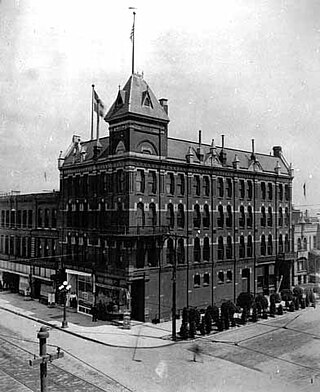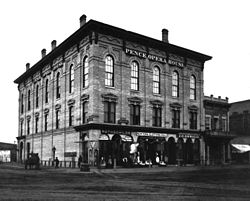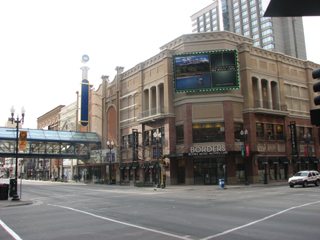
The Star Tribune is the largest newspaper in Minnesota. It originated as the Minneapolis Tribune in 1867 and the competing Minneapolis Daily Star in 1920. During the 1930s and 1940s, Minneapolis's competing newspapers were consolidated, with the Tribune published in the morning and the Star in the evening. They merged in 1982, creating the Star and Tribune, and it was renamed to Star Tribune in 1987. After a tumultuous period in which the newspaper was sold and re-sold and filed for bankruptcy protection in 2009, it was purchased by local businessman Glen Taylor in 2014.

Minneapolis City Hall and Hennepin County Courthouse, designed by Long and Kees in 1888, is the main building used by the city government of Minneapolis, as well as by Hennepin County, in the U.S. state of Minnesota. The structure has served as mainly local government offices since it was built, and today the building is 60 percent occupied by the city and 40 percent occupied by the County. The building is jointly owned by the city and county and managed by the Municipal Building Commission. The Commission consists of the chair of the County Board, the mayor of the City of Minneapolis, a member of the County Board and a member of the Minneapolis City Council. The County Board chair serves as the president of the Commission and the mayor serves as the vice president. The building bears a striking resemblance to the city hall buildings in Cincinnati and Toronto. The City Hall and Courthouse was added to the National Register of Historic Places in 1974.

The Cowles Center for Dance and the Performing Arts is a performing arts center and flagship for dance in downtown Minneapolis, Minnesota, United States. The Cowles Center was developed as an incubation project by Artspace Projects, Inc and includes the refurbished 500-seat Goodale Theater ; the Hennepin Center for the Arts, home to 20 leading dance and performing arts organizations; a state-of-the-art education studio housing a distance learning program; and an atrium connecting the buildings. The Cowles Center is a catalyst for the creation, presentation and education of dance in the Twin Cities.

The Pantages Theatre is a historic theatre in Minneapolis, Minnesota. The original building was a Beaux-Arts style twelve-story complex on Hennepin Avenue, designed by Kees & Colburn and operated by Alexander Pantages, a Greek immigrant who opened 500 theatres.

Target Field is a baseball stadium in the historic warehouse district of downtown Minneapolis. Since its opening in 2010, the stadium has been the ballpark of Major League Baseball's Minnesota Twins. The stadium hosted the 2014 Major League Baseball All-Star Game. It has also served as the home of other local and regional baseball events.

Minneapolis, officially the City of Minneapolis, is a city in the state of Minnesota and the county seat of Hennepin County. As of the 2020 census the population was 429,954, making it the largest city in Minnesota and the 46th-most-populous in the United States. Nicknamed the "City of Lakes", Minneapolis is abundant in water, with thirteen lakes, wetlands, the Mississippi River, creeks, and waterfalls. Minneapolis has its origins as the 19th century lumber and flour milling capitals of the world, and, to the present day, preserved its financial clout. It occupies both banks of the Mississippi River and adjoins Saint Paul, the state capital of Minnesota.

Orpheum Theatre is a theater located in downtown Minneapolis, Minnesota. It is one of four restored theaters on Hennepin Avenue, along with the Pantages Theatre, the State Theatre and the Shubert Theatre.

The Hennepin County Law Library is a law library located in Minneapolis, Minnesota, founded in 1883.

Marcy-Holmes is a neighborhood in the University community of Minneapolis. The majority of the area is residential and sits upon a bluff overlooking the river and the city skyline. However, a small section of the neighborhood along the river is an industrial zone.

The Gateway District of Minneapolis is centered at the convergence of Hennepin Avenue, Nicollet Avenue, and Washington Avenue. Its borders are not officially designated or recognized, but are visible as the Mississippi River to the northeast, Cedar Lake Trail and the railroad tracks to the northwest, Fifth Avenue South to the southeast. and Fourth Street South to the southwest. The district includes a significant part of the Downtown West neighborhood and abuts the North Loop.
Minneapolis is the largest city in the US state of Minnesota, and the county seat of Hennepin County.

The Minneapolis Fire Department provides fire protection and first responder emergency medical services to the city of Minneapolis, Minnesota.

The Unique Theater was an 830-seat vaudeville theater, built in 1904 on Hennepin Avenue in downtown Minneapolis, Minnesota. It was built in the Renaissance Revival style, and situated between the Hennepin Center for the Arts and the West Hotel.

The State Theatre is a historic theatre in Minneapolis, Minnesota, USA. It is one of four restored theatres in the Hennepin Theatre District.

Dania Hall was a cultural center and performing arts space in the Cedar-Riverside neighborhood of Minneapolis. Completed in 1886, the building was destroyed by an accidental fire in 2000 at the outset of an extensive renovation project.

Carl F. Struck was a Norwegian American architect, who designed private residences, civic buildings and commercial structures throughout the Midwest in the latter part of the 19th century.
Liebenberg and Kaplan (L&K) was a Minneapolis architectural firm founded in 1923 by Jacob J. Liebenberg and Seeman I. Kaplan. Over a fifty-year period, L&K became one of the Twin Cities' most successful architectural firms, best known for designing/redesigning movie theaters. The firm also designed hospitals, places of worship, commercial and institutional buildings, country clubs, prestigious homes, radio and television stations, hotels, and apartment buildings. After designing Temple Israel and the Granada Theater in Minneapolis, the firm began specializing in acoustics and theater design and went on to plan the construction and/or renovation of more than 200 movie houses throughout Minnesota, North and South Dakota, Iowa, and Wisconsin. Architectural records, original drawings, and plans for some 2,500 Liebenberg and Kaplan projects are available for public use at the Northwest Architectural Archives.
Punchinello Players, founded in 1914, was a theatre organization of the University of Minnesota. When it closed it was the second oldest student-run community theater in the U.S. Punchinello - located on the St. Paul campus - originated for the purpose of improving the lives of the greater community. As a university-associated theater it changed with the times and continued to explore and interrogate the human condition. Punchinello Players closed in 1994 due primarily to its home, North Hall, being slated for demolition.

















